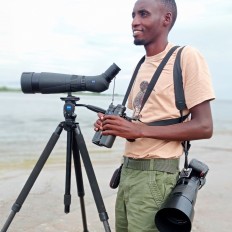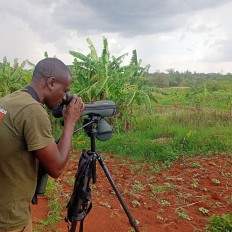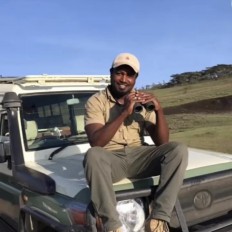Top species
- Blue-spotted Wood-Dove (Turtur afer)
- Eastern Plantain-eater (Crinifer zonurus)
- Blue-headed Coucal (Centropus monachus)
- Black Coucal (Centropus grillii)
- Blue Malkoha (Ceuthmochares aereus)
- Fiery-necked Nightjar (Caprimulgus pectoralis)
- Great White Pelican (Pelecanus onocrotalus)
- Goliath Heron (Ardea goliath)
- Palm-nut Vulture (Gypohierax angolensis)
- Banded Snake-Eagle (Circaetus cinerascens)
- Crowned Eagle (Stephanoaetus coronatus)
- Black-and-white-casqued Hornbill (Bycanistes subcylindricus)
- Blue-breasted Kingfisher (Halcyon malimbica)
- Blue-breasted Bee-eater (Merops variegatus)
- Madagascar Bee-eater (Merops superciliosus)
- Yellow-rumped Tinkerbird (Pogoniulus bilineatus)
- Yellow-fronted Tinkerbird (Pogoniulus chrysoconus)
- Double-toothed Barbet (Pogonornis bidentatus)
- Green-backed Woodpecker (Campethera maculosa)
- Red-headed Lovebird (Agapornis pullarius)
- Gray Parrot (Psittacus erithacus)
- Brown-throated Wattle-eye (Platysteira cyanea)
- Black-headed Gonolek (Laniarius erythrogaster)
- Papyrus Gonolek (Laniarius mufumbiri)
- Gray-capped Warbler (Eminia lepida)
- Carruthers's Cisticola (Cisticola carruthersi)
- Greater Swamp Warbler (Acrocephalus rufescens)
- White-headed Sawwing (Psalidoprocne albiceps)
- Angola Swallow (Hirundo angolensis)
- Swamp Flycatcher (Muscicapa aquatica)
- Snowy-crowned Robin-Chat (Cossypha niveicapilla)
- Olive-bellied Sunbird (Cinnyris chloropygius)
- Red-chested Sunbird (Cinnyris erythrocercus)
- Slender-billed Weaver (Ploceus pelzelni)
- Northern Brown-throated Weaver (Ploceus castanops)
- Vieillot's Black Weaver (Ploceus nigerrimus)
- Compact Weaver (Pachyphantes superciliosus)
- Red-headed Quelea (Quelea erythrops)
- Fan-tailed Widowbird (Euplectes axillaris)
- Black-and-white Mannikin (Spermestes bicolor)
- Green-backed Twinspot (Mandingoa nitidula)
- Fawn-breasted Waxbill (Estrilda paludicola)
- Western Citril (Crithagra frontalis)
- Papyrus Canary (Crithagra koliensis)
List up to ca. 25 species that:
• have a limited distribution range and/or are rare on a global level
• are most sought-after by birdwatchers at this site
• and are relatively easy to see at this site (year-round or seasonally)
| Blue-spotted Wood-Dove (Turtur afer) | |
| Eastern Plantain-eater (Crinifer zonurus) | |
| Blue-headed Coucal (Centropus monachus) | |
| Black Coucal (Centropus grillii) | |
| Blue Malkoha (Ceuthmochares aereus) | |
| Fiery-necked Nightjar (Caprimulgus pectoralis) | |
| Great White Pelican (Pelecanus onocrotalus) | |
| Goliath Heron (Ardea goliath) | |
| Palm-nut Vulture (Gypohierax angolensis) | |
| Banded Snake-Eagle (Circaetus cinerascens) | |
| Crowned Eagle (Stephanoaetus coronatus) | |
| Black-and-white-casqued Hornbill (Bycanistes subcylindricus) | |
| Blue-breasted Kingfisher (Halcyon malimbica) | |
| Blue-breasted Bee-eater (Merops variegatus) | |
| Madagascar Bee-eater (Merops superciliosus) | |
| Yellow-rumped Tinkerbird (Pogoniulus bilineatus) | |
| Yellow-fronted Tinkerbird (Pogoniulus chrysoconus) | |
| Double-toothed Barbet (Pogonornis bidentatus) | |
| Green-backed Woodpecker (Campethera maculosa) | |
| Red-headed Lovebird (Agapornis pullarius) | |
| Gray Parrot (Psittacus erithacus) | |
| Brown-throated Wattle-eye (Platysteira cyanea) | |
| Black-headed Gonolek (Laniarius erythrogaster) | |
| Papyrus Gonolek (Laniarius mufumbiri) | |
| Gray-capped Warbler (Eminia lepida) | |
| Carruthers's Cisticola (Cisticola carruthersi) | |
| Greater Swamp Warbler (Acrocephalus rufescens) | |
| White-headed Sawwing (Psalidoprocne albiceps) | |
| Angola Swallow (Hirundo angolensis) | |
| Swamp Flycatcher (Muscicapa aquatica) | |
| Snowy-crowned Robin-Chat (Cossypha niveicapilla) | |
| Olive-bellied Sunbird (Cinnyris chloropygius) | |
| Red-chested Sunbird (Cinnyris erythrocercus) | |
| Slender-billed Weaver (Ploceus pelzelni) | |
| Northern Brown-throated Weaver (Ploceus castanops) | |
| Vieillot's Black Weaver (Ploceus nigerrimus) | |
| Compact Weaver (Pachyphantes superciliosus) | |
| Red-headed Quelea (Quelea erythrops) | |
| Fan-tailed Widowbird (Euplectes axillaris) | |
| Black-and-white Mannikin (Spermestes bicolor) | |
| Green-backed Twinspot (Mandingoa nitidula) | |
| Fawn-breasted Waxbill (Estrilda paludicola) | |
| Western Citril (Crithagra frontalis) | |
| Papyrus Canary (Crithagra koliensis) |
Fan-tailed Widowbird (Euplectes axillaris) was added by Isaac Kilusu (2021-02-15 08:48:51)
Black-and-white Mannikin (Spermestes bicolor) was added by Isaac Kilusu (2021-02-15 08:47:20)
Green-backed Woodpecker (Campethera maculosa) was added by Isaac Kilusu (2021-02-15 08:45:28)
White-headed Sawwing (Psalidoprocne albiceps) was added by Isaac Kilusu (2021-02-15 08:44:24)
Yellow-fronted Tinkerbird (Pogoniulus chrysoconus) was added by Isaac Kilusu (2021-02-15 08:44:05)
Fiery-necked Nightjar (Caprimulgus pectoralis) was added by Isaac Kilusu (2021-02-15 08:42:25)
Northern Brown-throated Weaver (Ploceus castanops) was added by Isaac Kilusu (2021-02-15 08:42:05)
Crowned Eagle (Stephanoaetus coronatus) was added by Isaac Kilusu (2021-02-15 08:41:25)
Palm-nut Vulture (Gypohierax angolensis) was added by Isaac Kilusu (2021-02-15 08:40:44)
Eastern Plantain-eater (Crinifer zonurus) was added by Isaac Kilusu (2021-02-15 08:39:27)
Angola Swallow (Hirundo angolensis) was added by Isaac Kilusu (2021-02-15 08:38:20)
Slender-billed Weaver (Ploceus pelzelni) was added by Isaac Kilusu (2021-02-15 08:37:58)
Vieillot's Black Weaver (Ploceus nigerrimus) was added by Isaac Kilusu (2021-02-15 08:37:29)
Swamp Flycatcher (Muscicapa aquatica) was added by Isaac Kilusu (2021-02-15 08:37:09)
Brown-throated Wattle-eye (Platysteira cyanea) was added by Isaac Kilusu (2021-02-15 08:36:36)
Black-and-white-casqued Hornbill (Bycanistes subcylindricus) was added by Isaac Kilusu (2021-02-15 08:36:09)
Gray-capped Warbler (Eminia lepida) was added by Isaac Kilusu (2021-02-15 08:35:02)
Blue-spotted Wood-Dove (Turtur afer) was added by Isaac Kilusu (2021-02-15 08:32:58)
Black Coucal (Centropus grillii) was added by Isaac Kilusu (2021-02-15 08:32:09)
Blue-headed Coucal (Centropus monachus) was added by Isaac Kilusu (2021-02-15 08:31:43)
Great White Pelican (Pelecanus onocrotalus) was added by Isaac Kilusu (2021-02-15 08:30:36)
Goliath Heron (Ardea goliath) was added by Isaac Kilusu (2021-02-15 08:30:23)
Yellow-rumped Tinkerbird (Pogoniulus bilineatus) was added by Isaac Kilusu (2021-02-15 08:30:00)
Double-toothed Barbet (Pogonornis bidentatus) was added by Isaac Kilusu (2021-02-15 08:29:39)
Blue Malkoha (Ceuthmochares aereus) was added by Isaac Kilusu (2021-02-15 08:29:10)
Green-backed Twinspot (Mandingoa nitidula) was added by Isaac Kilusu (2021-02-15 08:28:31)
Fawn-breasted Waxbill (Estrilda paludicola) was added by Isaac Kilusu (2021-02-15 08:28:12)
Olive-bellied Sunbird (Cinnyris chloropygius) was added by Isaac Kilusu (2021-02-15 08:27:28)
Red-chested Sunbird (Cinnyris erythrocercus) was added by Isaac Kilusu (2021-02-15 08:27:08)
Red-headed Quelea (Quelea erythrops) was added by Isaac Kilusu (2021-02-15 08:26:53)
Banded Snake-Eagle (Circaetus cinerascens) was added by Isaac Kilusu (2021-02-15 08:26:30)
Compact Weaver (Pachyphantes superciliosus) was added by Isaac Kilusu (2021-02-15 08:26:09)
Western Citril (Crithagra frontalis) was added by Isaac Kilusu (2021-02-15 08:25:51)
Papyrus Canary (Crithagra koliensis) was added by Isaac Kilusu (2021-02-15 08:25:34)
Greater Swamp Warbler (Acrocephalus rufescens) was added by Isaac Kilusu (2021-02-15 08:25:16)
Madagascar Bee-eater (Merops superciliosus) was added by Isaac Kilusu (2021-02-15 08:25:01)
Blue-breasted Bee-eater (Merops variegatus) was added by Isaac Kilusu (2021-02-15 08:24:45)
Blue-breasted Kingfisher (Halcyon malimbica) was added by Isaac Kilusu (2021-02-15 08:24:19)
Black-headed Gonolek (Laniarius erythrogaster) was added by Isaac Kilusu (2021-02-15 08:23:57)
Papyrus Gonolek (Laniarius mufumbiri) was added by Isaac Kilusu (2021-02-15 08:23:36)
Carruthers's Cisticola (Cisticola carruthersi) was added by Isaac Kilusu (2021-02-15 08:23:18)
Red-headed Lovebird (Agapornis pullarius) was added by Isaac Kilusu (2021-02-15 08:23:01)
Snowy-crowned Robin-Chat (Cossypha niveicapilla) was added by Isaac Kilusu (2021-02-15 08:22:38)
Gray Parrot (Psittacus erithacus) was added by Isaac Kilusu (2021-02-15 08:21:04)





